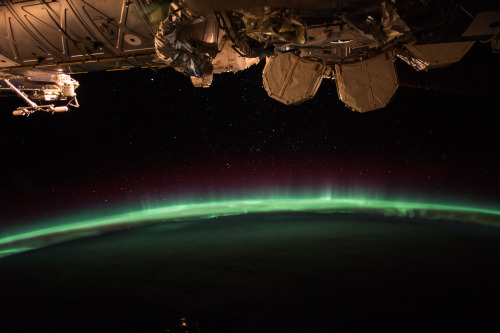Space-m17-blog - SpaceForLife
More Posts from Space-m17-blog and Others

Aurora from the ISS.
Photo credit: NASA






Illustration by Jean Luc Beghin for the 1970 edition of Spirou.
The top-right text says the image doesn’t depict any particular moment during the Apollo missions but that the two astronauts were picked arbitrarily: Frank Borman, commander of Apollo VIII (the first mission to fly around the moon) and Neil Armstrong, commander of Apollo XI (and the first person to walk on the moon).
I cleaned this image up a bit and the source-file can be found here, as well as other high definition scientific illustrations.

Sea Level Rise

For thousands of years, sea level has remained relatively stable. But now, Earth’s seas are rising. Since the beginning of the 20th century, they have risen about eight inches, and more than two inches in the last 20 years alone!

As water warms, it expands and takes up more space. That means that when oceans warm, the sea level rises. This summer, we’ve been researching exactly how global warming has impacted Greenland’s ice sheet. Our ICESat-2 mission will use a laser to measure the height of the planet’s surface. Over time, we will be able to provide a record of elevation change, and estimate how much water has melted into the ocean from land ice change.
So how much ice are we actually losing? Great question, but the answer might shock you. In Greenland alone, 303 gigatons of ice was lost in 2014!

Since we know that ice is melting, we’re working to gain a better understanding of how much and how fast. We’re using everything from planes, probes and boats, to satellites and lasers to determine the impact of global warming on the Earth’s ice.

Follow along for updates and information: http://climate.nasa.gov/

(12 Nov. 1966) — Astronaut James A. Lovell is photographed inside his Gemini spacecraft during the Gemini-12 mission. Astronaut Edwin Aldrin is seen in the background and to the left. Photo credit: NASA
The night sky. 09/03/15 Watch as the colour of the sky changes due to the rising Moon. This was a 4 hour time lapse recorded last night from 21:00-01:00.
Give support to this project

May 14, 2009 – A close-up view of astronaut John Grunsfeld performing spacewalk to do some maintenance on the Hubble Space Telescope, photographed by Andrew Feustel, who can be seen in Grunsfeld’s visor.
(NASA)

A photo of Jupiter. Took by Cassini with COISS on April 02, 2001 at 15:22:15. Detail page on OPUS database.
Hubble Space Telescope
You’ve probably heard of our Hubble Space Telescope, but have you had the chance to actually take a look at the amazing images it has captured for us over the years? Since Hubble launched in April 1990, it has made more than 1.2 million observations, some to locations more than 13.4 billion light years from Earth!
Hubble can see astronomical objects with an angular size of 0.05 arc seconds, which is like seeing a pair of fireflies in Tokyo from your home in Maryland…yea, that’s pretty far! This accuracy allows us to see images like this one of Little Gem Nebula, roughly 6,000 light-years away from us.

Images from Hubble are regularly released to the public, and are some of the most breathtaking views in the Universe. Images like this one of Lagoon Nebula, in the constellation of Sagittarius, not only make for amazing desktop screen-savers, but provide us with valuable scientific information about distant stars and galaxies, as well as the planets in our solar system.

We recently celebrated Hubble’s 25th Anniversary, and look forward to many more years of discovery and captivating images.
-
 panthera--tigris--altaica liked this · 6 years ago
panthera--tigris--altaica liked this · 6 years ago -
 iamdefinitelynotanalien liked this · 6 years ago
iamdefinitelynotanalien liked this · 6 years ago -
 afterthedragonflies liked this · 6 years ago
afterthedragonflies liked this · 6 years ago -
 jwmusiccreations liked this · 6 years ago
jwmusiccreations liked this · 6 years ago -
 cuts-on--her-wrists liked this · 9 years ago
cuts-on--her-wrists liked this · 9 years ago -
 47sealsandcounting liked this · 9 years ago
47sealsandcounting liked this · 9 years ago -
 space-m17-blog reblogged this · 9 years ago
space-m17-blog reblogged this · 9 years ago -
 paradoxfox-blog liked this · 9 years ago
paradoxfox-blog liked this · 9 years ago -
 irga-nav liked this · 9 years ago
irga-nav liked this · 9 years ago -
 the-beauty-of-space reblogged this · 9 years ago
the-beauty-of-space reblogged this · 9 years ago
I love space. I've been to space camp in Huntsville Alabama and I am planning on going every summer. I look forward to be an astronaut for nasa on the sls that is planned to be launched 2018. And the manned mission 2030. So yeah I won't let anything get in my way.
138 posts